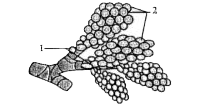Name the structures involved in the protection of the brain.
To answer the question regarding the structures involved in the protection of the brain, we will follow these steps:
1. Identify the Cranium:
- The first structure that protects the brain is the cranium. It consists of eight cranial bones that form a hard outer shell, often referred to as the "brain box." This structure provides a rigid protective barrier against physical impacts.
2. Understand the Meninges:
- Beneath the cranium, the brain is covered by three protective membranes known as the meninges. These layers provide additional protection and support to the brain.
3. List the Three Layers of Meninges:
- The meninges consist of three layers:
- Dura Mater: This is the outermost layer, which is thick and tough. It adheres closely to the inner surface of the skull.
- Arachnoid Mater: The middle layer, which is web-like in appearance (hence the name "arachnoid," which means spider-like). It provides a cushioning effect.
- Pia Mater: The innermost layer, which is thin, delicate, and highly vascularized. It closely invests the brain's surface.
4. Cerebrospinal Fluid (CSF):
- The cerebrospinal fluid is found in the space between the arachnoid mater and the pia mater. This fluid acts as a shock absorber, cushioning the brain and protecting it from mechanical injuries.
Summary of Structures:
- Cranium: Hard outer protective shell.
- Meninges: Three layers (Dura Mater, Arachnoid Mater, Pia Mater).
- Cerebrospinal Fluid: Fluid that provides cushioning and shock absorption.
- The first structure that protects the brain is the cranium. It consists of eight cranial bones that form a hard outer shell, often referred to as the "brain box." This structure provides a rigid protective barrier against physical impacts.
- Beneath the cranium, the brain is covered by three protective membranes known as the meninges. These layers provide additional protection and support to the brain.
- The meninges consist of three layers:
- Dura Mater: This is the outermost layer, which is thick and tough. It adheres closely to the inner surface of the skull.
- Arachnoid Mater: The middle layer, which is web-like in appearance (hence the name "arachnoid," which means spider-like). It provides a cushioning effect.
- Pia Mater: The innermost layer, which is thin, delicate, and highly vascularized. It closely invests the brain's surface.
- The cerebrospinal fluid is found in the space between the arachnoid mater and the pia mater. This fluid acts as a shock absorber, cushioning the brain and protecting it from mechanical injuries.
- Cranium: Hard outer protective shell.
- Meninges: Three layers (Dura Mater, Arachnoid Mater, Pia Mater).
- Cerebrospinal Fluid: Fluid that provides cushioning and shock absorption.
Topper's Solved these Questions
- BOOK - NCERT EXEMPLAR ENGLISHCHAPTER - NEURAL CONTROL AND CO-ORDINATIONEXERCISE - SHORT ANSWER TYPE QUESTIONS6videos
NEURAL CONTROL AND CO-ORDINATION
- BOOK - NCERT EXEMPLAR ENGLISHCHAPTER - NEURAL CONTROL AND CO-ORDINATIONEXERCISE - LONG ANSWER TYPE QUESTIONS3videos
NEURAL CONTROL AND CO-ORDINATION
- BOOK - NCERT EXEMPLAR ENGLISHCHAPTER - NEURAL CONTROL AND CO-ORDINATIONEXERCISE - LONG ANSWER TYPE QUESTIONS3videos
NEURAL CONTROL AND CO-ORDINATION
- BOOK - NCERT EXEMPLAR ENGLISHCHAPTER - MORPHOLOGY OF FLOWERING PLANTSEXERCISE - Long Answer Type Questions8videos
MORPHOLOGY OF FLOWERING PLANTS
- BOOK - NCERT EXEMPLAR ENGLISHCHAPTER - PHOTOSYNTHESIS IN HIGHER PLANTSEXERCISE - Long Answer type Question13videos
PHOTOSYNTHESIS IN HIGHER PLANTS
Similar Questions
Knowledge Check
- Question 1 - Select One
Assertion: -
 No and do not represent the resonance structures.
No and do not represent the resonance structures.
Reason :-The two structures involve a change in the position of atoms,AIf both Assertion and Reason are CORRECT and Reason is the CORRECT explanation of the Assertion.BIf both Assertion and Reason are CORRECT but Reason is not the CORRECT explanation of the Assertion.CIf Assertion is CORRECT but Reason is INCORRECT.DIf Assertion is INCORRECT but Reason is CORRECT.
Choroid plexuses of the brain are involved in the production of
View SolutionName the largest part of the brain
View SolutionName the organelles involved in photorespiration.
View SolutionStudy the diagram given below and answer the questions that follow:

Name the structure which is involved in gaseous exchange inside the lungs.View SolutionName the enzymes involved in the breakdown of nucleotides into sugars and bases?
View SolutionName all the steps involved in this process of sexual reproduction.
View SolutionName the blood cells involved in antibody production.
View Solution

